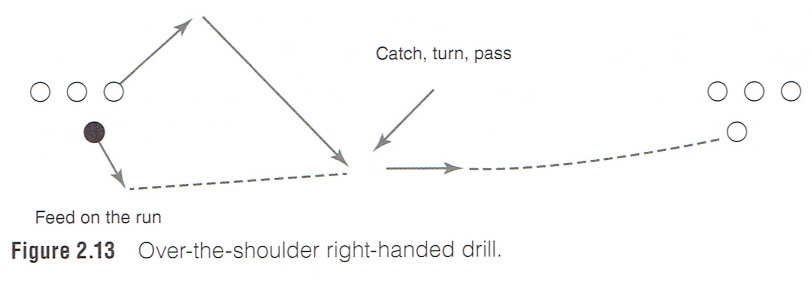| Line Drills |
| By: Jack Kaley and Rich Donovan
Originally Published in: Lacrosse Essentials Provided by: Human Kinetics All good teams have strong fundamentals. Line drills teach and reinforce proper technique in a relatively short time. Some coaches believe that players have mastered the fundamentals by the time they get to an advanced level and no longer need to practice them. However, even if players once executed good fundamentals, if they do not practice and reinforce them every day, their skills will deteriorate. Line drills can also be used for conditioning and to teach practice tempo. If designed properly, line drills give the players many repetitions to hone their stick skills. It is more important for players to execute successfully 50 percent of the time going at 100 percent speed, than to execute 100 percent going at only 50 percent speed. No team has won a championship at 50 percent speed, and no player has made All-American going 50 percent. The only way you can improve your efficiency at 100 percent is to practice at 100 percent. This achieves two elements for success: improved efficiency and conditioning. Players must be able to perform when they are tired. If you perform the drills properly at 100 percent speed, you will not only be able to execute when you are tired, but you also will develop eye-hand coordination and conditioning at the same time. Once the drill begins, the players continue executing it, running from line to line, even if they miss the ball. The second man in line is responsible for backing up each pass and catching a missed or deflected pass so that the drill keeps going. A player who misses a ball does not stop to retrieve the errant pass, but instead continues to run at full speed to the end of the line. If the second player in line does not back up the errant pass, the last man in line retrieves the ball, and a coach immediately throws another ball into the drill so that the movement is constant and the drill continues. You want to maximize movement and repetition for each drill. Each drill should last no more than 1 minute. If there are eight members in the group, each player should get at least four repetitions per drill. You should have 7 to 12 players per group; 8 or 9 is ideal. Groups should be arranged 30 to 40 yards apart so they have space to run full speed. It is essential that players be able to catch and throw at full speed. BALL IN THE AIR: INSIDE RIGHT-HANDED DRILL Purpose Setup In this drill, players imagine a box just above the receiver's shoulder on the stick side. The receiver keeps his stick in this box, which gives the passer a target (see figure 2.10). The passer must aim for this target every time. Execution This drill should move quickly because the ball is being passed in a straight line. If the receiver misses the ball, the second man in line should back up the ball on the fly, and the drill continues. The receiver runs into the ball with the stick up, providing a target for the passer. The receiver takes one quick cradle and then immediately releases the pass (see figure 2.11). If the group consists of 8 to 10 players, each player should get at least four repetitions in a minute. Coaching Points Emphasize stick position when receiving and catching the ball directly over the shoulder.
Variation: Outside Right-Handed Run this drill the same as the inside right-handed drill, but players make passes across their bodies to the outside of the oncoming player. It is a little more difficult to back up the feeds in this drill because the second player in line may not be able to catch the ball because the angle may be too far away from him. In this case, the last man in line retrieves the ball, and a coach throws another ball into the drill. The fundamentals emphasized are the same as in the previous drill (see figure 2.12).
Variation: Inside or Outside Left-Handed This drill is the same as the first drill except players throw and receive left-handed. The fundamentals are the same, but backing up may become more of a priority if this is the weak hand for most players. Variation: Over-the-Shoulder Right-Handed The purpose of this drill is to feed players cutting away up the field. The passers and receivers must move in this drill. The feeder passes over the shoulder of the receiver, who is breaking up field and is in line with the passer who is waiting to feed the line breaking out on the other side of the field. Keep the drill going in an even flow to maximize the time receiving and passing the ball and limit the time retrieving errant passes. If there are errant passes, the last man in line backs up those passes and retrieves them if he misses them. In this drill, one line passes the ball right-handed and the receiver catches the ball over his shoulder right-handed. The other line, breaking the opposite way, passes left-handed to a player breaking out, looking over his shoulder to make a left-handed catch. This is the last of the line drills (see figure 2.13).
|











